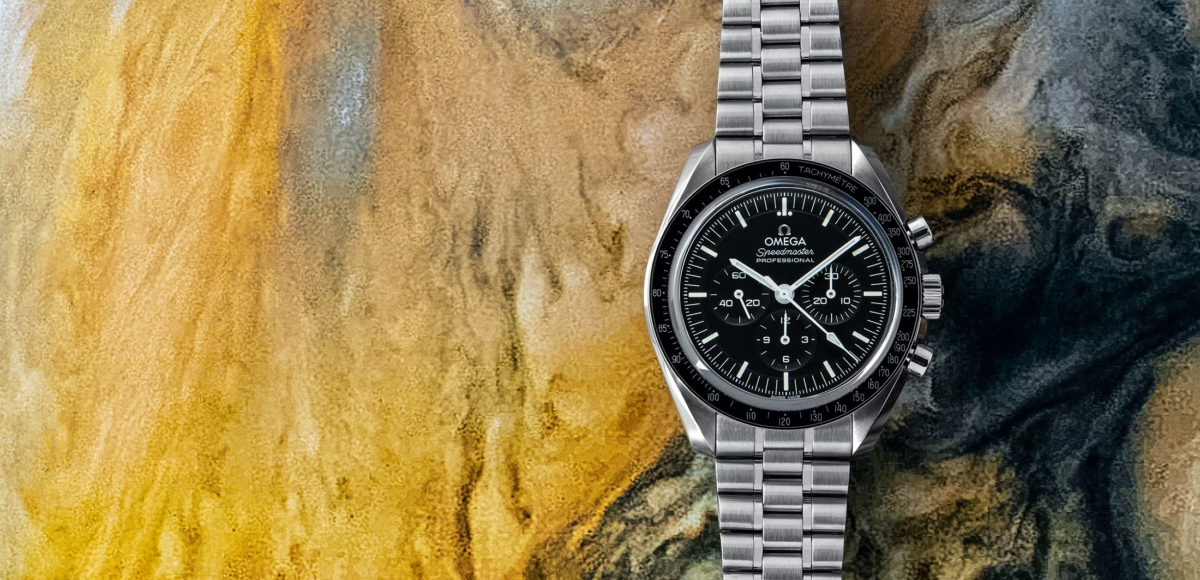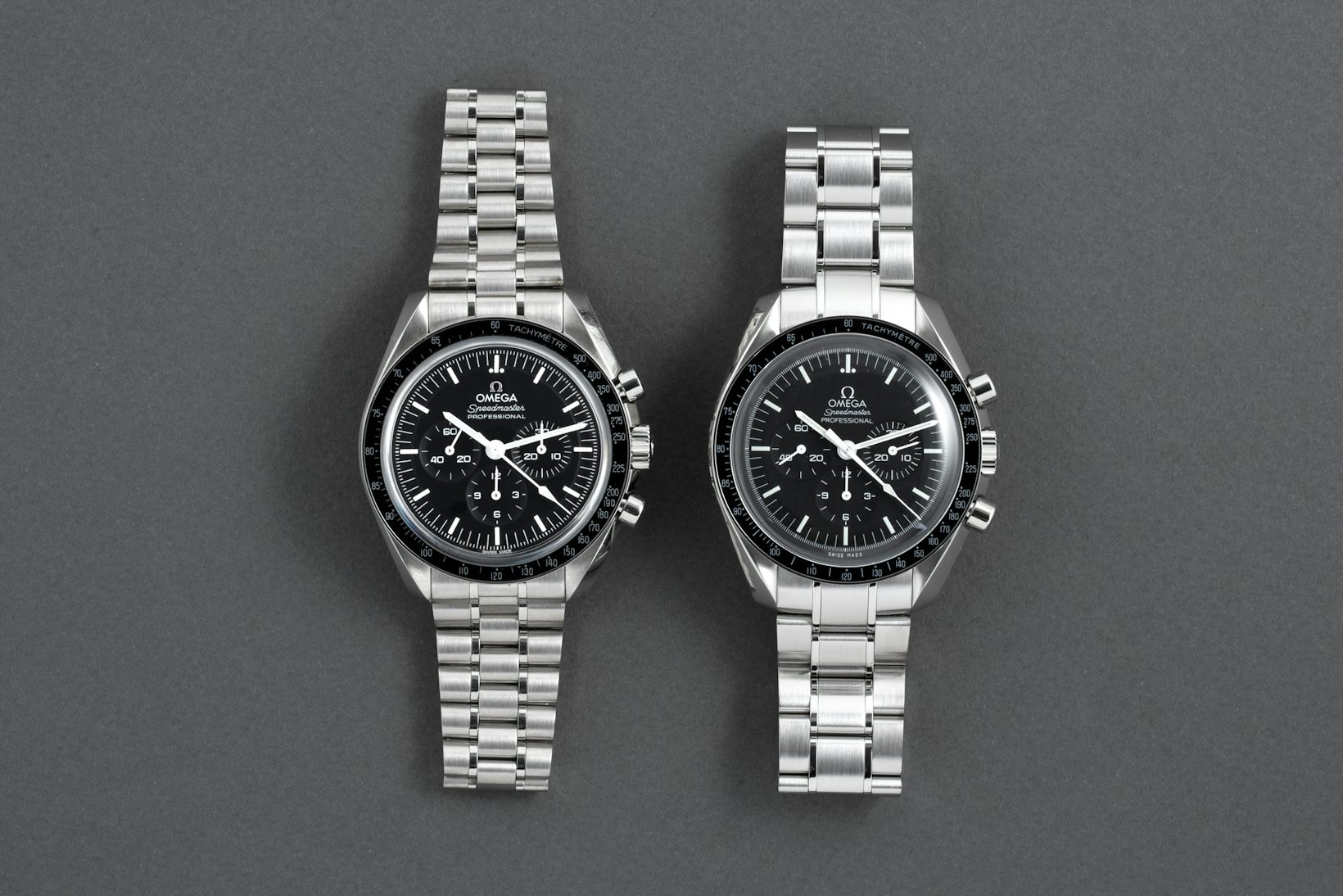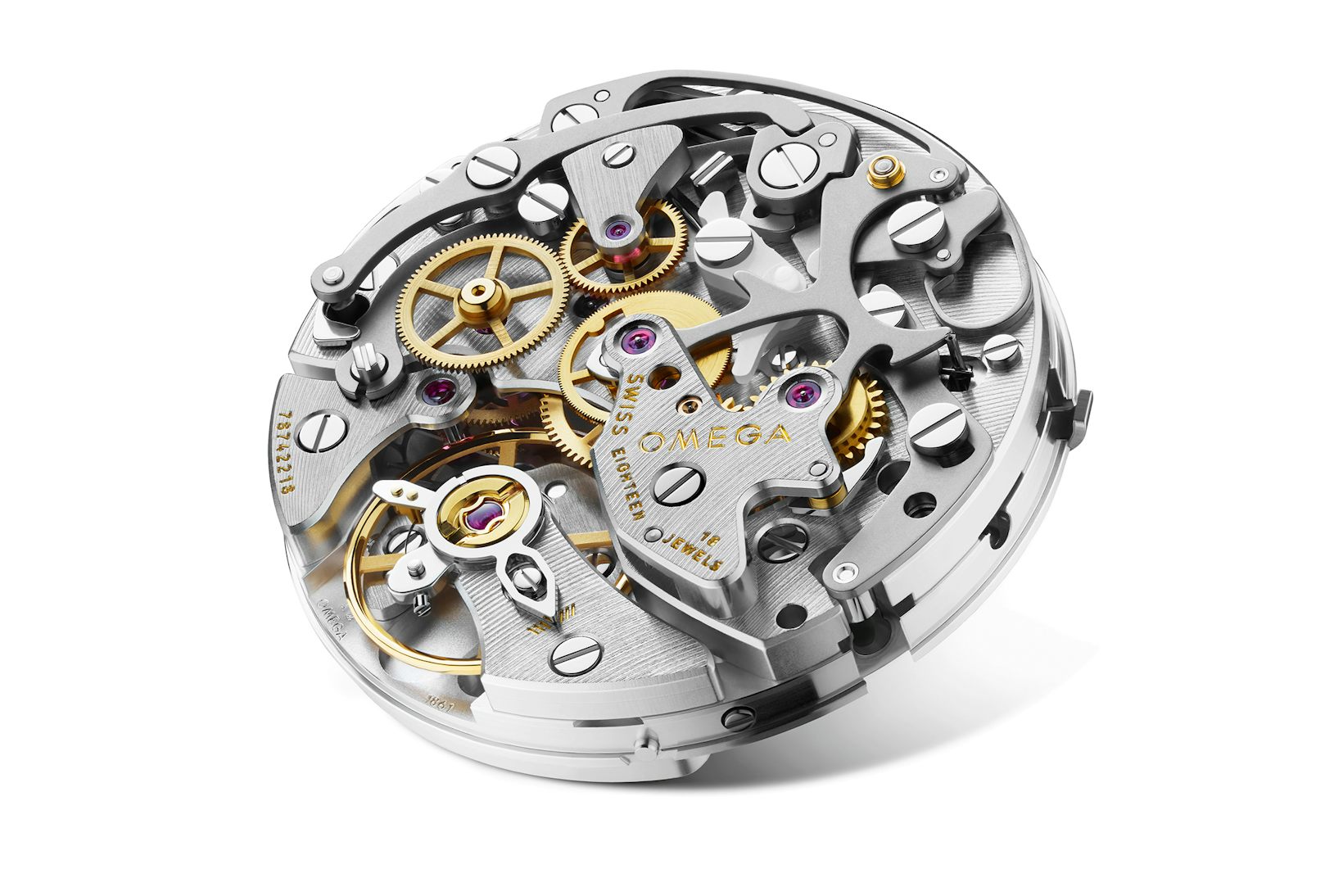A Week On The Wrist: The Omega Speedmaster Professional Moonwatch ‘Master Chronometer’ With Co-Axial Caliber 3861
With its first new motor in decades, the venerable Moonwatch is ready to rocket.
Thomas Wolfe wrote, “you can’t go home again” (in fact he made a whole book out of the sentiment), but for watch enthusiasts, the attraction of a number of different watches is that you can. The Omega Speedmaster Professional Moonwatch is a classic example. To paraphrase another fine author, Tolkien on Bilbo Baggins, you could call it well-preserved, but unchanged would be nearer to the mark. The Moonwatch got its last movement update in 1996, with the caliber 1861, but that movement is mechanically almost identical to the 861, which rolled out in 1968-1969.
Sure, the external appearance of the Moonwatch has changed over the years, but the most recent model with caliber 1861 – ref. 311.30.42.30.01.005, for the steel-on-steel version – is virtually indistinguishable from the previous ref. 145.022. That was the first Speedmaster to use the caliber 861 rather than the 321, and it was introduced all the way back in 1969, and was in production until 1988.
The joy and comfort of the Moonwatch has been the joy and comfort of coming back to your childhood home after years, or decades, of withstanding the moil and toil of being a grownup, and finding your old bedroom as you left it, right down to your worn-to-a-frazzle Steiff bear reposing on the faded counterpane.
Changing anything about the Moonwatch, therefore, runs the risk of producing in the Speedmaster faithful the same basic reaction you’d get if you moved a deer’s favorite salt lick. But change is exactly what has come to the Moonwatch.
While it’s still near-impossible for anyone who’s not deeply immersed in the forensics of Speedmaster design details to tell the difference, well, consider me immersed. The new Speedmaster Moonwatch “Master Chronometer” is in my estimation a significant update both mechanically and cosmetically.
In terms of externals, the changes are relatively minor (although they’re major signals to Speedmaster fans), and the biggest change is probably to the bracelet, rather than the watch itself. In fact, the new bracelet has probably gotten as much attention as the changes to the dial and bezel. The biggest change is under the hood, where we find a new movement: the co-axial caliber 3861, which is Master Chronometer certified, and which makes the Moonwatch a thoroughly modern member of Omega’s lineup of co-axial escapement watches.
First Impressions
As a Speedmaster fan going all the way back to the birth of crewed space flight in the 1960s (Apollo kids unite!), I regarded the Master Chronometer Moonwatch with a certain amount of anxiety. Oh, sure, we’d done an Introducing post, and then James Stacey analyzed the differences between the various new 3861 Moonwatch models and the outgoing ref. 311.30.42.30.01.005, and through all of that scrutiny, it looked darned fine – no, ma’am, excuse me, damned fine.
But the gap between press-release photo and actual, in-the-metal first impressions can be a big one, and I was afraid of all sorts of things. Would it feel too retro-adjacent for its own good? Kitschy? Overdone? God forbid, coldly disconnected from the illustrious history of use in manned space flight which distinguishes previous Moonwatches? Would it seem, in short, a pretender rather than a legitimate heir to the throne?
As it turned out, the old and new Moonwatch look a lot more like identical twins than mere siblings. That much-discussed new bracelet looked like a game-changer at first glance, and by gosh if it wasn’t a game-changer when I saw it in person.
We all know that a new bracelet or new strap can change the experience you have of a watch pretty dramatically (or make you curse the day you blew two hundred bucks on yet another “perfect strap” and immediately start wondering where you put your spring bar tool). The new Master Chronometer bracelet improves on the one thing I didn’t love without reservation about the preceding Moonwatch: The bracelet that came with that watch was pas mal, pas mal, but it didn’t quite rise to greatness. This one does.
The bracelet also raises the whole Hesalite vs. sapphire question – our review sample was one of the so-called sapphire sandwich watches, with sapphire crystals front and back. The bracelet for the sapphire version has polished interlinks, while the Hesalite version’s are brushed. Another difference is that the Hesalite (acrylic) crystal version of the Moonwatch Master Chronometer comes with a solid caseback, as was the case with its predecessor.
Cole Pennington took a look at the pros and cons of each, last January, and while he was essentially agnostic on the issue, there are, to my mind, pros and cons. If you’re a real purist, the Hesalite version is a no-brainer, though you won’t be able to admire the movement. The sapphire sandwich version gives you the full visual experience front and back, and of course, sapphire won’t show wear and tear the way Hesalite does. But it’s not, strictly speaking, in spec for manned space flight, at least according to the notion that a sapphire crystal, if shattered, will leave nasty shards drifting around the crew cabin.
Is that a real problem, though? Maybe. For comparison, look at writing instruments used in space. The Fisher Space Pen, which uses a nitrogen-filled cartridge to maintain ink pressure, was developed for crewed space flight; there is a joke that NASA spent millions on developing it, while the frugal Soviets stuck to pencils. This myth has been repeatedly debunked (by Scientific American, among others), and it turns out the Soviets and NASA both got away from pencils pretty quickly, as particles of graphite and wood shavings are potential and undesirable contaminants. I would imagine a shattered sapphire crystal might present similar hazards – although watches with sapphire crystals have been worn on crewed missions, so apparently, NASA is not super-doctrinaire on this point.
Anyway, the new bracelet is really something. At least at first glance, you get the feeling that if someone were a Speedmaster fan, did not know that the Master Chronometer version had been released, and they saw one of these on your wrist, their first reaction might not be, “Hey, where’d you get the new model Speedmaster?” but rather, “Wow, where’d you get that bracelet?”
The Co-Axial Caliber 3861
The bracelet may be the biggest visible change when the Moonwatch Master Chronometer is on the wrist, but turn the watch over, and you see the real news: the Omega Co-Axial caliber 3861. Master Chronometer certification is a combination of two testing procedures. The first is testing of the movement by the COSC, which is responsible for certifying all Swiss-made chronometer movements as running within chronometer specs. The second is METAS certification, which includes testing for resistance to magnetic fields, testing for deviation of rate across the usable power reserve, and other functional tests. In particular, METAS certification means the tested watch is capable of resisting magnetic fields up to at least 15,000 gauss, which is about the strength produced by the magnet in an MRI machine. (Just the thing for the first manned mission to Jupiter, which has a magnetic field an order of magnitude stronger than the Earth’s.)
It is also adjusted to within a maximum daily deviation in rate of 0/+5 seconds per day, though as far as I can tell, this is a somewhat modest figure. The Master Chronometer watches I’ve had a chance to test drive have generally performed not only within spec, but generally much better – one to two seconds per week, as a rule, if that. Our review watch was no exception, and over a week’s time, it gained about two seconds measured against the HODINKEE app setting clock.
As with the topside view of the Moonwatch Master Chronometer, it is at first glance not so easy to tell you’re looking at a new movement. This is partly due to the fact that while nominally this is a new caliber, it is really a new chapter in the ongoing evolution of the original caliber 321, which was first used by Omega under that designation back in 1949. There’s a more detailed breakdown on how the 321 gradually evolved to the 1861 in our Week On The Wrist with the Moonwatch caliber 321. Briefly, the column wheel, Breguet overcoil, copper-plated 321 was replaced, beginning in 1968, with the lever-and-cam, flat balance spring caliber 861. In 1996, the 861 received rhodium plating and an additional jewel, upping the count from 17 to 18. This new version was the caliber 1861. A display back version of the 1861 was made as well, which swapped out the Delrin (plastic) brake lever of the 1861 for a metal one. This was the caliber 1863.
A side-by-side comparison does reveal some subtle visible differences, although the most dramatic differences between the two calibers are functional rather than cosmetic.
The 3861 also has some visible differences that are clues that you’re looking at a 3861. Take a look at the balance cock (the metal projection that acts as the support for the upper balance pivot). The 1861 has a standard regulator system, while the 3861 does not; that’s because the 3861 has a free-sprung adjustable mass balance, in which rate is regulated with timing weights on the balance itself.
The timing weights are a little hard to spot, but if you’ve got good eyesight (and maybe a loupe), they’re there all right. They’re in the form of screws, located on the rim of the balance between the spokes – above, you can see one at about 10:00 on the balance rim. And, of course, the bridge for the chronograph seconds and minutes recorder wheels is helpfully engraved “Ω Omega 3861” as well.
The level of finish is almost the same between the 1861 and the 3861, but it’s not identical. Both have beveled bridges and nicely finished countersinks for the jewels, but one pretty subtle difference between the two is that the bridge for the chronograph intermediate wheel – above, at about 10:00, between the driving wheel on the left and the chronograph seconds wheel in the center – has anglage in the 3861, and it doesn’t in the 1861. I spent a lot of time staring at the caliber 3861 over the week we had it, and I thought once or twice that the anglage on the 3861 was maybe a hair wider, but I wouldn’t swear to it under oath. (The finish on the display-back caliber 1863, on the other hand, looks virtually identical to the 3861).
Should I get some flak for dwelling on the movement? I obviously don’t think so. (My HODINKEE colleagues tease me every once in a while for being such a gearhead, but that’s to be expected since taste as refined as mine doesn’t come along every day).
But I also think there’s a good argument to be made for understanding the technical and aesthetic evolution of the 3861 as a path to better appreciation of the watch. The Moonwatch is a beautiful wristwatch, but it’s also a tool which for much of its history has been expected to put up with hard knocks and come through unscathed, and the movements inside have a lot to do with that. Knowing something about how the 3861 descended from the 321 – and it is a direct line of descent both technically and aesthetically – adds an awful lot to the emotional experience of wearing the Moonwatch Master Chronometer (and, in my case at least, goes a long way towards relieving where-the-hell’s-my-salt-lick level anxiety).
A Week On The Wrist
Reader, I married it.
Okay, I didn’t but I would have. Granted, when it comes to the Moonwatch, I’m like Ron Weasley after Romilda Vane hits him with the love potion – googly-eyed, uncritical, adoring; a moping mess of a fanboy. Still, though, I was prepared to find fault with the 3861 if I could, usurper though it might be. As it turns out, however, I got something that was less an overthrower of the Moonwatch from its throne than a subtle but marked improvement on almost every level – Daniel Craig’s James Bond after Vesper Lynde puts him in a suit that actually fits.
The outgoing 1861 Moonwatch is never going to lose its appeal. It was the first good Swiss watch I ever owned, it would probably be the last I ever get rid of if I had to sell off my worldly goods to buy a new crutch for Tiny Tim, and I will love it until the day I shuffle off this mortal coil and join the choir invisible. However, that doesn’t stop me from knowing a good thing when I see it, and the new 3861 is Very. Damned. Good.
The updated bracelet is a joy and a wonder, and it makes me wish Omega had revised the Moonwatch bracelet a long time ago, but better late than never – in this case, much better. The little details that differentiate the MMC from its immediate predecessor are on their own not especially pronounced – that dot over 90 (which, admittedly at this point for Speedmaster fans, is the equivalent of a giant neon sign flashing I AM HAZ VINTAGE VIBES, but I still like it) and the step dial are subtle – but they add up. Taken all together, the look and feel of the new bracelet, respectful updates to the dial and bezel, and the new movement really do give the Moonwatch new clarity – as if you were, so to speak, listening to The Omega Speedmaster Moonwatch, Remastered.
The MMC charms the eye and feels great on the wrist, but how does it feel to use as God and Gene Kranz intended? Well, the switching system is identical, so you’d expect the chronograph pusher feel to be identical as well. I certainly don’t have anything like a reliable sample size to base this on, but it felt noticeably smoother to me than my personal 1861 Moonwatch (sorry ol’ girl), which may be just down to the Moonwatch Master Chronometer we had being factory fresh. It may, however, also reflect some subtle optimization of construction and/or setup at the factory.
One remaining question: Is this new Moonwatch flight-qualified? The answer, at least for now, is a qualified yes. I checked in with Omega on this, and much to my very pleasant surprise, the new Moonwatch was put through the same battery of tests originally done by NASA when they qualified the original 321 Speedy for crewed space missions. That includes the vibration tests, hot/cold tests, the high-decibel sound exposure test, the whole shootin’ match. What I have not been able to verify is whether or not the watch is considered “flight-qualified” on NASA’s side, but I can’t think why it wouldn’t be. In any case, I think it’s entirely reasonable to consider the Moonwatch Master Chronometer flight-qualified – de facto, certainly, if not de jure – a worthy companion on the off chance you ever get a Golden Ticket to the ISS.
The other caveat to bear in mind is that if you want a flight-qualified model, strictly speaking, you should go for the solid caseback model with Hesalite crystal. This will also give you the pleasure of looking down on the sapphire model as a decadent aberration from the True Faith, suitable only for aesthetes – but you’ll miss out on being able to look at the new movement.
I would have thought that owning an 1861 Moonwatch would confer an immunity against the 3861, and it’s true that they are very similar variations on a theme. Moonwatch In The Key Of Adventure, as it were. But the Moonwatch Master Chronometer is different enough – and it must be said, better enough technically – to have an appeal all its own. If you’re going to update an existing, beloved, iconic watch in the full knowledge that you mess with a classic at your peril, this is the way to do it.
The Omega Speedmaster Professional Moonwatch With Co-Axial Caliber 3861: case, stainless steel, 42mm diameter, sapphire crystal; aluminum bezel with tachymetric scale. Movement, co-axial caliber 3861, running in 26 jewels at 21,600 vph; 50-hour power reserve; three-register chronograph, METAS and Master Chronometer certified. Antimagnetic to at least 15,000 gauss; rate, 0/+5 seconds per day.
Price: Steel with Hesalite, $6,300.
Still photos, Tiffany Wade.
Shop Talk
Get More Articles Like This in Your Inbox
We're constantly creating great content like this. So, why not get it delivered directly to your inbox? By subscribing you agree to our Privacy Policy but you can unsubscribe at any time.





















































